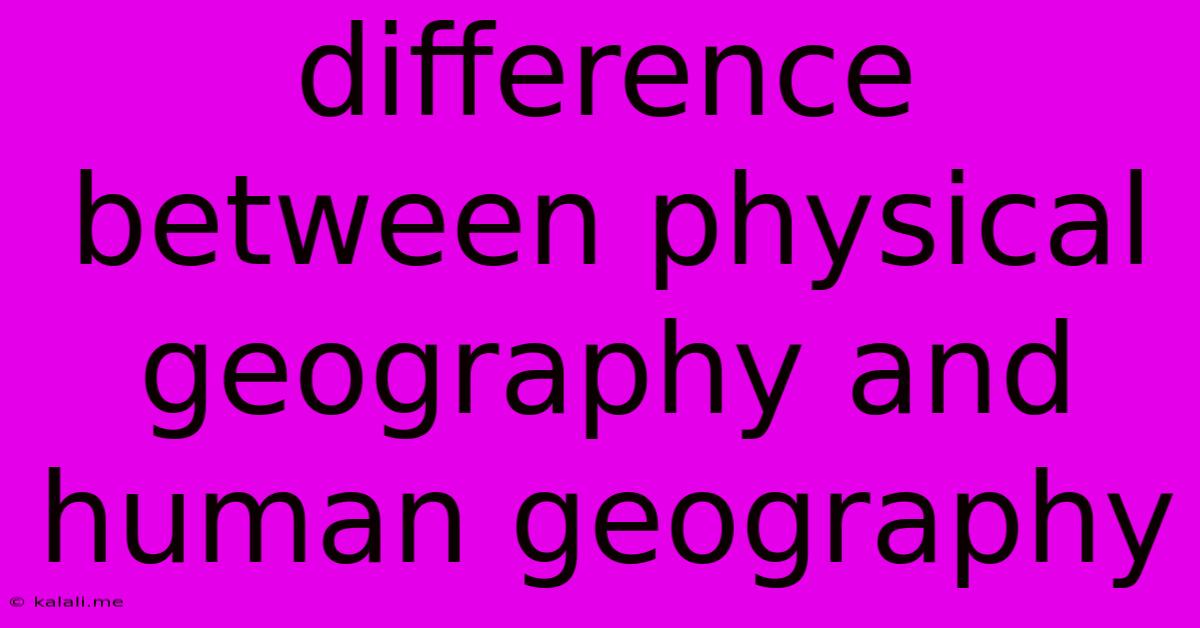Difference Between Physical Geography And Human Geography
Kalali
Jun 15, 2025 · 3 min read

Table of Contents
Unveiling the Earth: The Key Differences Between Physical and Human Geography
Understanding our planet requires exploring both its physical form and the human societies that inhabit it. This is where the disciplines of physical geography and human geography come into play. While both branches of geography are intertwined and often overlap, they focus on distinct aspects of the Earth and its inhabitants. This article delves into the core differences between these two crucial fields of study, providing a clear understanding of their scope and methodology.
What is Physical Geography?
Physical geography, also known as geosystems, examines the Earth's natural processes and features. It's a scientific endeavor investigating the interactions between the atmosphere, lithosphere, hydrosphere, and biosphere. Think of it as the study of the planet's physical systems and how they change over time.
Core Focus Areas of Physical Geography:
- Geomorphology: The study of landforms, their processes of formation, and their evolution. This includes mountains, valleys, rivers, coasts, and glaciers. Understanding erosion, deposition, and tectonic plate movement is central to geomorphology.
- Climatology: Focusing on the Earth's climate patterns, weather systems, and climate change. This involves analyzing temperature, precipitation, wind patterns, and their impact on various ecosystems.
- Hydrology: The science of water on Earth, encompassing its distribution, movement, and quality. This includes the study of rivers, lakes, groundwater, and oceans, as well as water cycles and their influence on the environment.
- Biogeography: The study of the distribution of plants and animals across the globe and the factors that influence their spatial patterns. This involves considering climate, geology, and human impact on biodiversity.
- Pedology (Soil Science): Examining soil formation, composition, and classification. Understanding soil properties is critical for agriculture, environmental management, and understanding landscape evolution.
What is Human Geography?
Human geography explores the spatial organization of human activities and their relationship with the environment. It delves into the "why" behind the distribution of populations, cultures, economies, and political systems across the globe. It's less about the physical processes themselves and more about how humans interact with and shape the Earth.
Core Focus Areas of Human Geography:
- Population Geography: Studying population distribution, density, growth, migration patterns, and their impact on societies and environments. This includes analyzing demographic transitions and forecasting future population trends.
- Cultural Geography: Examining the spatial distribution and interactions of cultures, including languages, religions, customs, and traditions. This explores how cultural landscapes are shaped and how cultures adapt and change over time.
- Economic Geography: Analyzing the spatial organization of economic activities, including industries, trade, and development. This involves studying factors influencing economic growth, regional disparities, and globalization.
- Political Geography: Examining the spatial organization of political systems, including states, boundaries, and power dynamics. This involves analyzing geopolitical issues, conflicts, and the role of geography in international relations.
- Urban Geography: Focusing on the spatial patterns and processes within cities and urban areas, including urban growth, planning, and social inequalities. This considers factors driving urbanization and the challenges associated with rapid urban growth.
The Intertwined Nature of Physical and Human Geography:
While distinct, physical and human geography are fundamentally interconnected. Human activities are heavily influenced by physical environments, and conversely, human actions significantly alter physical landscapes. For example, deforestation (human action) impacts climate patterns (physical process), while the availability of fertile land (physical factor) influences agricultural practices and population distribution (human factors). Many geographical studies now embrace an integrated approach, recognizing the complex interplay between human and natural systems. This integrated approach is often called environmental geography.
In conclusion, physical geography focuses on the Earth's natural systems, while human geography centers on the spatial organization and interactions of human societies. Understanding both disciplines is essential for a comprehensive grasp of our planet and the complex relationship between humanity and its environment. Both fields use a variety of methodologies, from fieldwork and data analysis to remote sensing and GIS technologies. They are crucial for addressing contemporary global challenges such as climate change, resource management, and sustainable development.
Latest Posts
Latest Posts
-
How Many Cm In A Micron
Jun 15, 2025
-
South Dakota State University Gpa Requirements
Jun 15, 2025
-
One Gram Of Fat Has How Many Calories
Jun 15, 2025
-
What Causes Hysteresis Loss In A Transformer
Jun 15, 2025
-
Which Of The Following Is Not A Consequence Of Urbanization
Jun 15, 2025
Related Post
Thank you for visiting our website which covers about Difference Between Physical Geography And Human Geography . We hope the information provided has been useful to you. Feel free to contact us if you have any questions or need further assistance. See you next time and don't miss to bookmark.